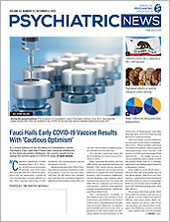The pandemic has prompted unprecedented changes in health care, including psychiatric practice, changing norms before we can consider their ethical implications. In particular, outpatient psychiatrists are reacting to the way telehealth alters boundaries, consultation-liaison (C-L) psychiatrists are contending with unique COVID-19 ethics dilemmas, and public health policymakers is grappling with issues of bias and injustice.
Telemedicine is suddenly mainstream. In May, APA conducted a survey (
Psychiatric News) about members’ use of telehealth before and after the public health emergency. Whereas before the pandemic, 64% of respondents used no telehealth in any of their patient encounters, a mere two months later, 85% were using telehealth for 76% to 100% of their clinical work. Initially, we were mostly focused on getting the technology to work for us and our patients, paying attention to only the most obvious ethical issues, like privacy and confidentiality in clinician and patient environments. We fretted about how to ensure the patient’s room is private if we can’t see the entire space. Eventually, other concerns surfaced, like hidden obstacles to confidentiality in the form of eavesdropping or recording devices. If the psychiatrist or the patient has an Alexa or Echo device within earshot, might it start recording or even speaking in response to what it hears? Might the patient intentionally record the session without the psychiatrist’s knowledge or consent? Might the psychiatrist do so without the patient’s consent?
Telepsychiatry has provoked a loosening of boundaries. A previous Ethics Corner on boundaries written in April feels quaint now (
Psychiatric News). Then, it felt awkward that patients could see one wall of my home. Now, many of them ask to see my dog if they hear him bark or squeak a toy. To deny that request would seem cruelly withholding. Only recently have I moved my dog to a different room when I have patient appointments, reducing the temptation to cross this boundary. On the one hand, an opinion piece in the
Washington Post by Lori Gottlieb, author of
Maybe You Should Talk to Someone, reveals several ways in which the loosening of boundaries because of seeing patients in their homes enhances the therapy. On the other hand, she admits to downgrading her wardrobe, which is disconcerting. It is respectful to dress professionally, as we would if we were in our offices.
Just as outpatient psychiatrists are faced with a variety of new ethical dilemmas, C-L psychiatrists are encountering new challenges, too. When should they see a patient in person, using up precious personal protective equipment, and when is it better to do an evaluation via telehealth? In addition to adapting their consultations to include telehealth when appropriate, C-L psychiatrists may encounter new kinds of consult requests, such as evaluating whether patients have the capacity to request to leave the hospital against medical advice during the pandemic or assessing patients who want to change their status to do not resuscitate to conserve resources for others. Johns Hopkins has published an excellent resource, “Capacity Assessments During the COVID-19 Pandemic,” to help clinicians navigate these unique situations.
Psychiatrists may also be concerned with the ethics of public policy decisions during the pandemic. We are experts on cognition and communication and can help shift the conversation about personal responsibility for public health (for example, wearing masks and conforming to physical distancing guidelines) when we notice and correct bias in messaging. “Cognitive Bias and Public Health Policy During the Pandemic” identifies four types of bias evident in the public narrative that compromise public safety. Using specific examples of public health messages that contain cognitive errors, such as overfocusing on ventilators and ICU beds, the authors offer alternative positive messages about masks and sheltering at home as lifesaving interventions in which we can all participate.
Perhaps the most distressing ethical problem highlighted by the pandemic is the absence of justice, defined as equal access to treatment for all, in U.S. health care. While Donald Trump is able to receive an experimental monoclonal antibody in phase 2/3 trials, 44 million Americans are without health insurance. Much has been written about disparities in health outcomes during the pandemic; a summary from the Substance Abuse and Mental Health Services Administration is a good place to start if you want to delve more deeply into the intersections between race, behavioral health, and COVID-19.
In closing, several types of ethical dilemmas have been uncovered or created by our responses to the pandemic. No doubt, there are many more. Among the many aspects of society altered by this devastating experience will be certain norms of psychiatric practice. One possible outcome from all the suffering we are witnessing may be a correction of public policy bias that has perpetuated injustice for some of our most vulnerable populations. ■
“The Surprising Intimacy of Online Therapy Sessions During the Pandemic” by Lori Gottlieb is posted
here.
“Capacity Assessments During the COVID-19 Pandemic” is posted
here.
“Cognitive Bias and Public Health Policy During the Pandemic” is posted
here.
“Double Jeopardy: COVID-19 and Behavioral Health Disparities for Black and Latino Communities in the U.S.” is posted
here.

